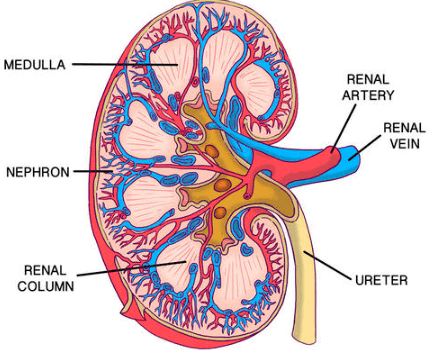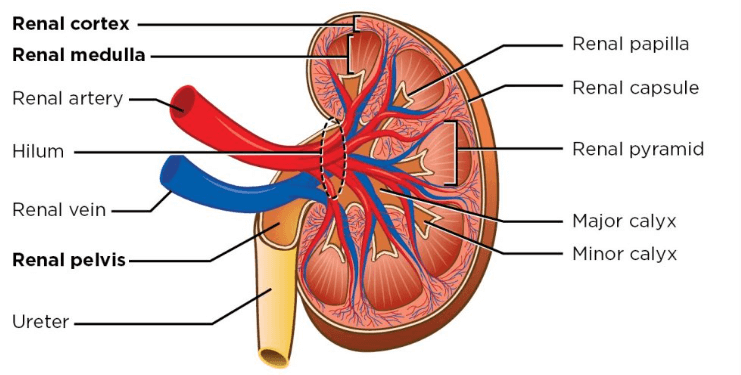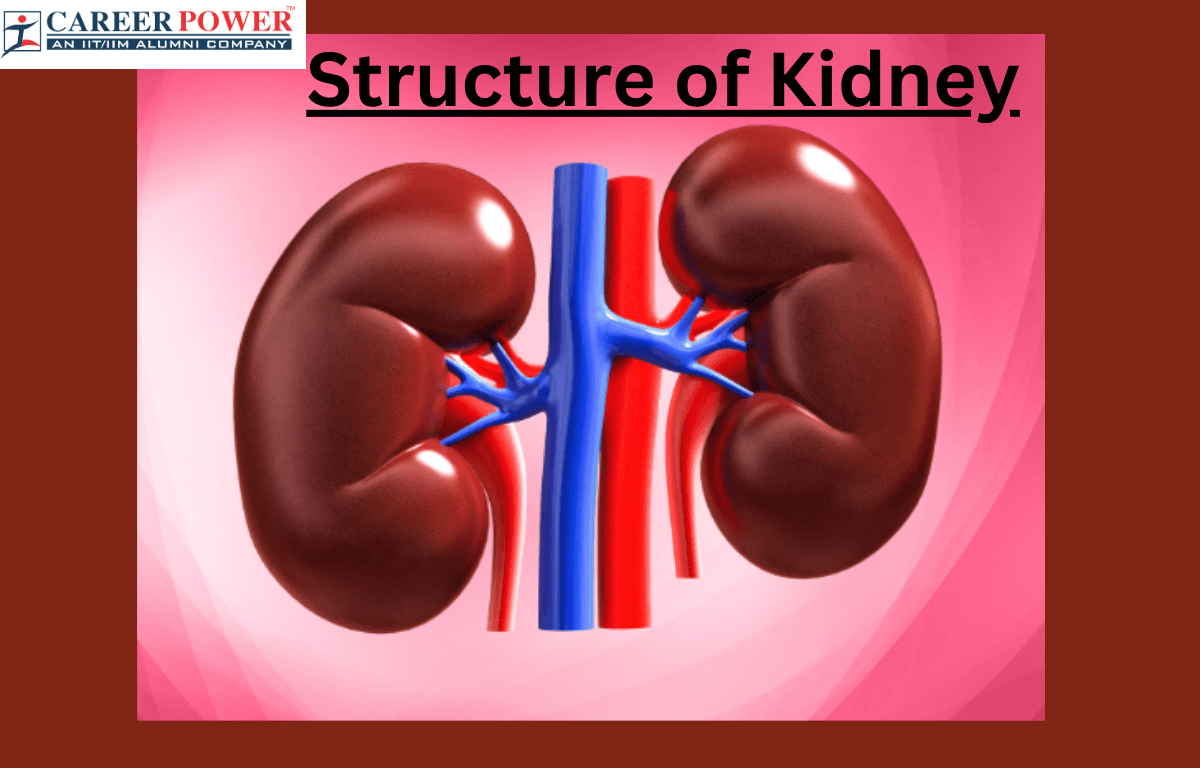The excretory system is a complex biological system that plays a vital role in maintaining the body’s internal environment. The primary organs of the excretory system are the kidneys. We can also say the excretory system, with the kidneys as its central organs, is responsible for filtering blood, removing waste products, maintaining proper water and electrolyte balance, and eliminating urine from the body. These functions are very important for maintaining the body’s internal equilibrium and overall well-being.
Kidney
The kidney is a bean-shaped vital organ in the human body responsible for filtering waste products and excess substances, such as water and electrolytes, from the blood to form urine. It also helps regulate red blood cell production and electrolyte balance. Humans typically have two kidneys, one on each side of the spine, and they play a crucial role in maintaining overall body homeostasis. Kidneys are essential for maintaining the body’s fluid and electrolyte balance. They help regulate blood pressure by controlling the volume of blood and the amount of sodium reabsorbed into the bloodstream.

Kidneys also contribute to the production of erythropoietin, a hormone that stimulates the bone marrow to produce red blood cells, and they are involved in the activation of Vitamin D, which is necessary for calcium absorption and bone health. Inside each kidney, there are approximately one million tiny structures called nephrons, which are responsible for the filtration process. The nephron is the structural and functional unit of the kidney. The waste and excess substances are filtered from the blood from urine, which is then transported to the bladder through the ureters and eventually expelled from the body during urination. Proper kidney function is crucial for maintaining overall health and well-being.
Structure of Kidney Diagram
The diagram of the structure of the kidney typically shows its main components, including the renal pelvis, ureter, and renal blood vessels. It also illustrates smaller units like nephrons, which are the functional units of the kidney responsible for filtering blood and producing urine. The diagram helps in understanding how the kidney filters waste products and excess substances from the blood to form urine, which is then excreted from the body.

Structure of Kidney
The kidney has a bean-shaped structure and is about the size of a human fist. The kidney has a complex structure that enables it to perform its essential functions. The main structure of a kidney includes the Renal Cortex, Renal Medulla, Renal Pelvis, Renal tubules, ureters, calyces, nephrons, glomerulus, Bowman’s capsule, and renal tubules. The intricate arrangement of each structure inside the kidney allows the kidney to filter the blood, remove waste products, regulate electrolyte balance, and maintain fluid balance within the body. Here’s a brief overview of the different structures of the kidney:
| Different structures of the Kidney | |
| Structure | Description |
| Renal Cortex | The renal cortex is the outer layer of the kidney; contains renal corpuscles and tubules essential for blood filtration. |
| Renal Medulla | Located beneath the cortex, divided into renal pyramids which carry urine from the cortex to the renal pelvis. |
| Renal Pelvis | It is a funnel-like structure in the center of the kidney; collects urine from pyramids and leads to the ureter. |
| Nephrons | The nephron is the functional unit of the kidney. It filters blood, producing urine; each nephron includes renal corpuscle and tubule. |
| Ureters | Ureters are muscular tubes connecting kidneys to the bladder. The ureters help in the transportation of urine from the kidney to the bladder. |
| Renal Artery | The renal artery carries waste-filled blood to the kidneys for filtration. |
| Renal Vein | The renal vein returns filtered blood back to circulation after processing in the kidney. |
| Renal Capsule | A tough, fibrous layer surrounding each kidney, providing it with protection and maintaining its shape. |
| Renal Columns | Extensions of the renal cortex that project into the renal medulla, providing support and containing blood vessels. |
| Minor Calyces | Cup-shaped structures that collect urine from the renal pyramids and transport it to the major calyces. |
| Major Calyces | Major Calyces are larger structures formed by the fusion of minor calyces, which further collect urine and channel it into the renal pelvis. |
| Papilla | The papilla is the tip of each renal pyramid that releases urine into the minor calyces. |
| Perirenal Fat | Adipose tissue surrounding the kidneys, providing cushioning and insulation. |
| Renal Sinus | A cavity within the kidney that contains blood vessels, nerves, lymphatic tissue, and the renal pelvis. |
| Bowman’s Capsule | Cup-shaped structure at the start of a nephron, encasing the glomerulus (network of blood vessels). |
| Glomerulus | A dense network of capillaries inside the Bowman’s capsule where blood filtration occurs. |

- Renal Cortex: The outer layer of the kidney is called the renal cortex. It contains structures like renal corpuscles and renal tubules, which are essential
- Renal Medulla: Beneath the cortex lies the renal medulla, which is divided into renal pyramids. These structures contain tubules that carry urine from the cortex to the pelvis.
- Renal Pelvis: The renal pelvis is a funnel-like structure in the kidney’s center. It collects urine from the renal pyramids and funnels it into the ureter, which carries the urine to the bladder.
- Nephrons: Nephrons are the functional units of the kidney and are located in the cortex and medulla. Each kidney contains about one million nephrons. A nephron consists of renal corpuscles (comprising Bowman’s capsule and Glomerulus) and a renal tubule.
- Ureters: These are muscular tubes that connect the kidneys to the bladder. They transport urine from the kidney to the bladder for storage.
- Renal Artery and Renal Vein: The renal artery supplies blood to the kidneys, carrying waste-filled blood that needs to be filtered. The filtered blood is then returned to circulation through the renal vein.
- Bowman’s Capsule: A double-walled, cup-shaped structure at the beginning of the nephron. It encloses a network of tiny blood vessels called the glomerulus.
- Glomerulus: A dense network of capillaries inside Bowman’s capsule. Blood is filtered here, and the filtrate (which becomes urine) enters the renal tubule.
- Renal Tubules: These are long, twisted tubes where the filtrate from the glomerulus is processed and modified. These are several segments of renal tubules, including the proximal convoluted tubules, loop of Henle, distal convoluted tubule, and collecting duct.
- Vasa Recta: These are blood vessels associated with juxtamedullary nephrons, helping maintain medullary concentration gradient.
Functions of Kidney
The kidney plays several crucial functions in the human body. These functions are crucial for maintaining overall bodily functions and keeping the internal environment stable.
- Filtration of Blood: The primary function of the kidney is to filter waste products, excess substances, and toxins from the bloodstream to form urine.
- Regulation of blood pressure: Kidneys help regulate blood pressure by controlling the volume of blood and the concentration of salts and water in the body.
- Red Blood Cell Regulation: They produce erythropoietin, a hormone that stimulates the bone marrow to produce red blood cells, thus helping in the regulation of oxygen-carrying capacity in the blood.
- Acid-Base Balance: Kidneys maintain the balance of acids and bases in the body, which is essential for normal cell function and metabolism.
- Electrolyte Balance: They regulate the levels of electrolytes such as sodium, potassium, and calcium in the body, which are essential for various physiological processes.
- Detoxification: Kidneys help in removing drugs and other harmful substances from the body, contributing to the detoxification process.
- Water Balance: They adjust the excretion of water in response to the body’s needs, helping in maintaining proper hydration levels.
You can also go through our article on: Excretion in Human Beings



 50 Vegetables Name for Kids in English a...
50 Vegetables Name for Kids in English a...
 Food Chain: Definition, Types, Examples,...
Food Chain: Definition, Types, Examples,...
 Human Respiratory System: Definition, Di...
Human Respiratory System: Definition, Di...













